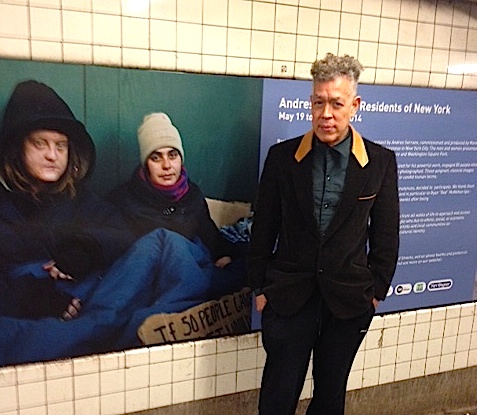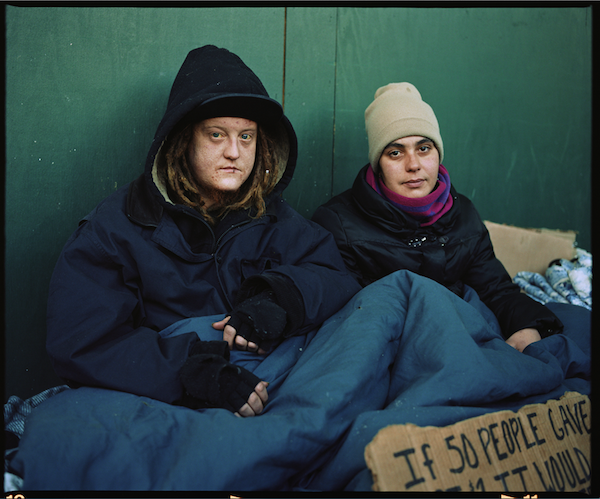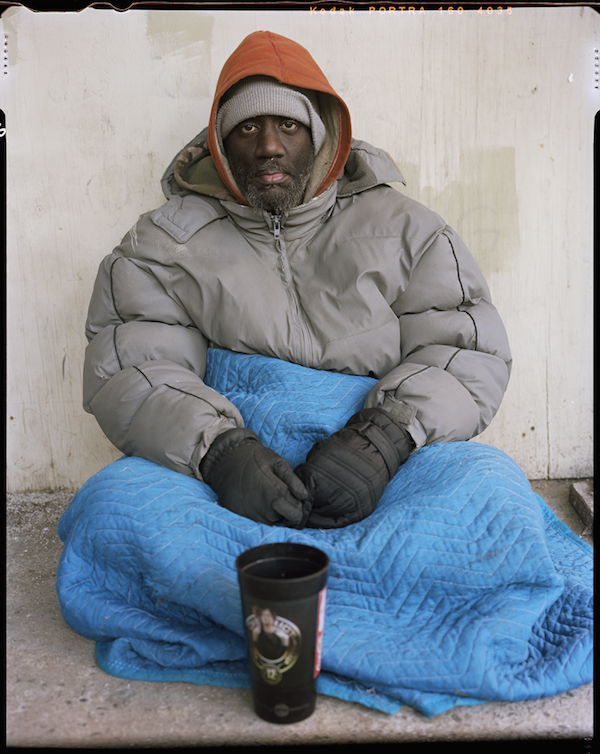American artist and photographer Andres Serrano creates imagery that makes us see our seemingly-obvious world in a new way. From his early work, which mixed the effluents of the human body with Christian imagery, to his most recent outing, on view through June 15 at a New York subway station, Serrano incites powerful reactions.
When I recently spoke with Andres Serrano, we began with his current installation, “Residents of New York,” and then explored inspiration, social media and political contexts.

Adam Leipzig: What’s going on in the subway?
Andres Serrano: I’ve got a public art installation at the Washington Square West Fourth Street Station, along the corridors after you go through the turnstile. It’s sponsored by More Art, and it’s called, “Residents of New York.” They’re portraits of homeless people that I photographed back in January of this year, in New York.
AL: How large are they?
AS: They’re normal poster size, probably 60 by 80 inches.
AL: They’re placed where subway advertisements would usually be.
AS: Exactly. It’s in place of the advertisements.
AL: What was your source of inspiration for this series? Did you know that it was going to be a series when you started, or did you just start taking some photos and then it developed along the way?
AS: I had been invited by More Art to do a public installation, and we had talked about it about a year ago. In August, I thought the direction was going to be that I would find homeless people on the streets and bring them to the studio. I tried that for one afternoon, and then decided not to pursue that avenue.
Then, in October, I started to notice more people than ever on the streets, asking for money. I was struck by the signs that they used. So I started buying the signs from the homeless, and explaining that I thought ever sign was a story and I wanted to tell their story, and build up a collection. I bought about 200 signs, walking the streets almost every day during the month of October. I would walk five, six, seven hours a day. One time I even walked 10 hours, in search of the signs to buy.
I always made a point of walking everywhere, because I feel like the homeless live on the streets, they walk the streets, so I had to walk the same streets that they walked, in search of people with signs. By the end of October I collected 200 signs, and I made it into a video called “Sign of the Times,” which I finished around December.
Then in early January, it occurred to me that what I really wanted to go into the streets and photograph the homeless the way I found them on the street. So I got an assistant with a 4×5 camera, because I’ve never used a 4×5 camera before. The idea was to take studio like portraits, except not to take them in a studio but in their natural environment.
AL: Did you bring in some lighting or was it all natural lighting?
AS: It’s all natural lighting, but because the equipment is heavy, we had to walk around with a hand truck carrying all of the equipment. We did this mostly in January, and a couple of weeks in February. It was very cold, but again, I felt like I had to go where the homeless are, and they’re out there in the cold. So I had to do it the same way.
AL: Was there one of the signs that particularly moved you?
AS: There was one sign I bought from a young girl, who looked no older than 16: “Mom told us to wait right here. That was 10 years ago.” I thought that was pretty moving sign considering how young the kid was. But the overwhelming message from all of the signs was pretty much the same, which is, “I’m homeless, and I’m hungry, and I’m here.”
AL: How did you approach the people you wanted to photograph?
AS: Usually, the people are sitting on the street, just sitting there. I wouldn’t sit next to them because I feel that is their space, and it would be an invasion for me to sit next to them without being invited to do so. I would just crouch down and say, “Can I talk to you?” I’m in their space, so I’m asking permission to begin the conversation. Most of them said, “Yeah, sure, what’s on your mind?” And I would say, “Listen, I’m an artist and I see things in a certain way, and one of the things I see is the signs that the homeless have, and I’ve been going around buying these signs.” That’s what I would say when I was buying the signs. Pretty much I said the same thing when I wanted to photograph people, except this time I said, “I would like to take your picture, and I can offer you $50.” I paid them $50 for their portrait.

AL: As I’m looking at the photographs as they’re installed in the subway passageway, they remind me of the images that you see along the walls of churches, the portraits of saints leading towards the altar.
AS: Oh wow, that’s a good interpretation. One of the things that I was thinking of, even before I started the series, was the photographs done by the WPA photographers and artists who were commissioned by the government to go out there and record the Depression, to inspire America with some of these images, which are very compelling and moving, such as Dorothea Lange’s portrait of a migrant mother. It’s funny because if you look up migrant mother by Dorothea Lange, she’s on Wikipedia. That’s the power of a photograph. A photograph can make a person famous just by being in that photograph.
Initially with my work, I did some black and whites because I wanted to refer to that era, to, you know, to the photographs that documented the Depression. If you’ll look at some of the black and whites, you can’t really tell that they were taken in 2014, they look like they were part of that era as well.
AL: A sad commentary of how little America has progressed in terms of people who are often forgotten.
AS: Exactly. The homeless are the extreme in terms of poverty, but I feel there are a lot of people who may not be there, but they’re close to it. You know, they’re struggling.
AL: Yeah. I live in Los Angeles, and in the past year, the Los Angeles homeless population has come to rival New York’s. It’s well over 50,000, which is an all-time high.
AS: Wow. In December, I went to Paris for a show with Yvon Lambert Gallery, and Yvon showed the “Signs of the Times” video. I’ve been to Paris 30 times in the last 25 years, and it struck me that there were more homeless than even in Paris. I had never seen so many homeless there before. It’s a world-wide condition.
AL: It is. Your photographs make me think about what creative people do. For example, I write a lot and I often feel that I shouldn’t have to write what I write, because it’s pretty obvious, it’s right there in front of everybody’s face. But the fact is that other people aren’t writing it down. And therefore, part of my obligation is to write it down, because what a writer does is write what everybody knows anyway, but he actually writes it. In the same way, you photograph what we all see, out of the corners of our eyes, in our peripheral vision, but don’t really pay attention to.
AS: I’m actually an artist with a camera, a little more conceptual than just a photographer. I’m drawn to ideas as much as to situations, people, or scenery. But I’ve always felt that my work is extremely simple. It’s easy to understand, you get it, you know?
You go in the subway, you see three or four people with a homeless sign, you know that all the other portraits there, and they’re all homeless. It’s like you said: You’re stating the obvious, but it’s not obvious to a lot of people, even though it should be. That’s what makes a writer like Ernest Hemingway so great because the simplicity of the language. It looks like anybody can do this, or anybody should be doing it, but nobody else is, and that’s what makes it special. It’s so clear and simple, and yet no one else can define it until you come along and put your name on it.
AL: It goes to an issue, a cultural issue, that troubles me, that so many people accept being led and need to be led, and need leaders whether the leaders are artists, or politicians, or corporate bosses. It frustrates me that many people want to be led for most of their lives.
AS: We’re in an era where social media has taken precedence over our lives, and people are walking down the street with their iPhones attached to their hands. They can’t part with it. A lot of the information they’re getting is from media or from social media. And most of it is bullshit, you know? But people have to be fed something, and they chose to absorb the things that the lightest for them to take in. It’s a very different then 30, 40 years ago when news was almost like a special thing. Now, when anything that happens, it’s immediately known to half the world.
AL: There are 100 hours of video content uploaded to YouTube every minute. There are 20 billion photos on Instagram. Anyone can use Instagram, so everybody seems to be a photographer, but is everybody really a photographer?
AS: Well, that’s the thing. I choose to use film. I don’t like to manipulate the images in the dark room. When something is too easy, and everyone else is doing it, that’s when I don’t want to do it. I’m not saying I would never shoot digital. If I was in a situation where you don’t have any alternative, of course I would go to digital. But for now, I choose to use film.
Sometimes I see some photographs on the Internet, drop-dead gorgeous photograph by people who are amateurs, by people who are not professionals, by people who are just taking pictures. And yet these images become clichés and they don’t have any presence in the art world, or anywhere else, and you wonder why. I think there still is a difference between art and a photograph that’s just a photograph.

AL: How would you define that difference?
AS: By how compelling it is. It’s not enough to just be beautiful, aesthetically pleasing, but it also has to have more, because there are billions of images out there now that are so beautiful. Ansel Adams’s work has been redone a hundred times over, by competent amateurs and professionals. And yet, Ansel Adams still retains his position. Why? Probably because he came first.
AL: In general, do you have an agenda for your work?
AS: I’m not a crusader. I’m not a politician. Thanks to people like More Art who have their hearts in the right place, a certain kind of art can be brought to the attention of the public. Even though I don’t have a political agenda, or even a social one, I’m very happy that, in a way, this work that I’ve done as an artist, reflecting what I see, can be seen as a sort of a social campaign.
AL: When you say that you don’t have a political or a social agenda, I don’t entirely buy that. You may not have a political agenda in terms of Red States or Blue States, or Republicans or Democrats, but certainly in the broadest, most ancient Greek sense of the polis, of the civic commons which we all share, you do have a very specific perspective. You have chosen to make these portraits instead of other portraits.
AS: Well you know, sometimes as an artist, I chose not to state the obvious. But yeah. I’ve got a brain and I’ve got a heart, and it shows in my work.
Video of the installation:
More Art Presents: Andres Serrano: Residents of New York from More Art on Vimeo.
Top image courtesy More Art. All photographs copyright © 2014 by Andres Serrano. All Rights reserved.
